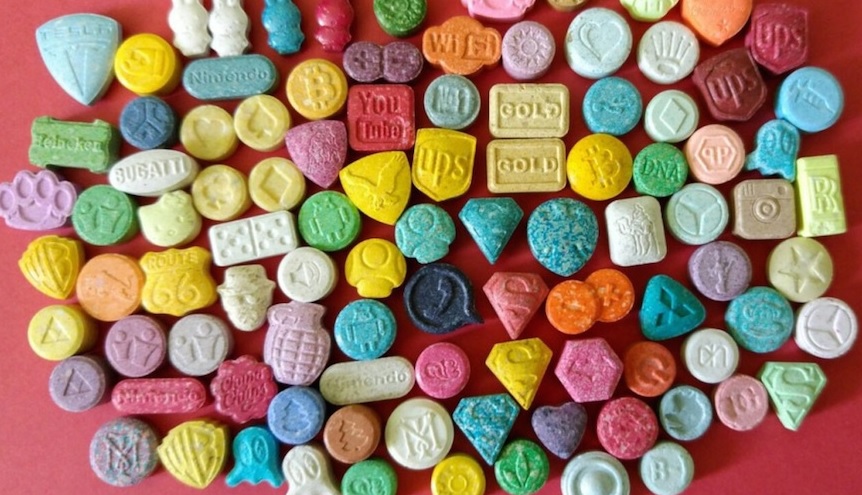
Ecstasy - A Popular Party Drug
Ecstasy, also known as MDMA (3,4-methylenedioxy-methamphetamine), is a synthetic psychoactive drug that has gained popularity in recent years, especially among the younger generation. Its street names include E, X, Molly, and Adam. Ecstasy is usually consumed in the form of colorful tablets or capsules, often imprinted with different logos or designs, which can be seen in the image above.
While individuals may use Ecstasy for various reasons, it is most commonly associated with the party and rave culture. The drug is known for its stimulant and hallucinogenic effects, which enhance feelings of empathy, euphoria, and sensory stimulation. However, it is crucial to note that the consumption of Ecstasy comes with significant risks and potential adverse health effects.
The Risks and Side Effects of Ecstasy
Despite its popularity, Ecstasy is not without its dangers. The drug affects the brain by altering the levels of neurotransmitters such as dopamine, serotonin, and norepinephrine. These neurotransmitters play a crucial role in regulating mood, emotion, sleep, and appetite.
Some of the immediate effects of Ecstasy include increased energy, heightened emotional sensations, and a feeling of closeness to others. However, these positive effects are often accompanied by negative consequences such as:
- Dehydration
- Involuntary teeth clenching and jaw tightness (known as bruxism)
- Increased heart rate and blood pressure
- Severe overheating
- Increased body temperature
- Muscle tension and tremors
- Overwhelming anxiety and panic attacks
- Impaired judgment and decision-making
- Memory loss and cognitive deficits
Concerns about Ecstasy Purity and Dosage
Since Ecstasy is an illegal drug, it is primarily produced in illicit labs, leading to concerns about its purity and quality. As a result, users can never be certain of the exact dosage or what other substances may be present in the tablets or powder they are consuming.
This lack of knowledge greatly increases the risks associated with Ecstasy use. Individuals may unintentionally consume a higher dose than intended, leading to potential overdose and life-threatening complications. Additionally, the presence of adulterants or other substances in Ecstasy can significantly amplify the drug’s negative effects and pose additional health risks.
Effects on Dental Health
One of the lesser-known side effects of Ecstasy is its impact on dental health. The stimulant properties of the drug, coupled with the clenching and grinding of teeth (bruxism) often associated with its use, can result in severe dental issues. This includes:
- Teeth grinding, leading to enamel erosion, tooth fractures, and even tooth loss
- Increased tooth sensitivity and pain
- TMJ (temporomandibular joint) disorders and facial muscle tension
- Gum disease and periodontal issues
Therefore, it is essential for those who use Ecstasy to be cautious and aware of these potential dental complications. Regular dental check-ups, proper oral hygiene practices, and seeking professional dental care can help mitigate some of these risks.
How to Prepare an Ecstasy Cocktail
While we do not endorse or encourage drug use in any form, we can provide harmless alternatives for those interested in experiencing the flavors associated with an Ecstasy cocktail. Here is a recipe for a non-alcoholic Ecstasy-inspired mocktail:
Ingredients:
- 1 oz blue curaçao syrup
- 1 oz pineapple juice
- 1 oz orange juice
- 1 oz lemon-lime soda
- Ice cubes
Instructions:
- Fill a cocktail shaker with ice cubes.
- Add blue curaçao syrup, pineapple juice, and orange juice.
- Shake well to mix the ingredients.
- Strain the mixture into a glass filled with ice cubes.
- Top it off with lemon-lime soda.
Preparation Time:
Preparation time for this refreshing mocktail is approximately 5 minutes.
Servings:
This recipe serves one person.
Nutrition Facts:
As this is a non-alcoholic mocktail, it does not contain any alcohol calories. However, the ingredients used in this recipe contain varying amounts of calories, sugars, and carbohydrates.
Tips:
For an added twist, garnish the mocktail with a slice of orange or a pineapple wedge. You can also experiment with different fruit juices or carbonated drinks to customize the flavors according to your preferences.
FAQs:
Q: Is Ecstasy addictive?
A: Yes, Ecstasy can be addictive. Prolonged use may lead to dependence and risk of experiencing withdrawal symptoms when discontinuing its use.
Q: Can Ecstasy be used for medicinal purposes?
A: No, Ecstasy is not approved for any medical uses. Its consumption is strictly illegal and considered a controlled substance in most countries.
Q: What are the long-term effects of Ecstasy use?
A: Long-term Ecstasy use may lead to various physical and mental health issues, including memory problems, depression, anxiety, and decreased serotonin production.
Q: Is it safe to mix Ecstasy with alcohol?
A: No, combining Ecstasy with alcohol or other drugs can increase the risks and potentially have severe consequences on both physical and mental health.
Q: How long does Ecstasy stay in the system?
A: The detection timeframe for Ecstasy in urine, blood, or hair samples varies, but it can generally be detected for up to 2 to 4 days after use.
Please note that the content of this post is for informational purposes only and does not endorse or promote drug use. If you or someone you know is struggling with substance abuse, seek professional help from a healthcare provider or addiction specialist.